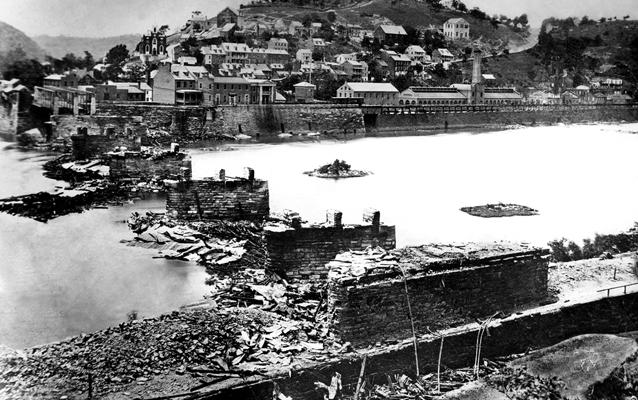Last updated: April 26, 2022
Place
Baltimore & Ohio Bridge Ruins

HFNHP Collection (Harpers Ferry NPS)
Historical/Interpretive Information/Exhibits, Scenic View/Photo Spot
The Baltimore & Ohio (B & O) railroad bridge was once a majestic wood covered bridge that spanned the Potomac River and carried train traffic on the B & O Railroad for 23 years prior to the outbreak of the Civil War. In 1859, John Brown, a staunch abolitionist, launched a raid across this bridge to capture the United States Armory and start a war to end slavery. Brown failed at his attempt but made a major impact on the Harpers Ferry area. With the secession of Virginia in April, 1861, the bridge became a tenuous connector between the Confederacy and the Union. The bridge was over an important border, the Potomac River, and constantly had to worry about attacks from both sides of the war. During four years of Civil War, the bridge would be built and destroyed nine times - four times by war, five times by floods.
On June 14, 1861, as the Confederates were leaving Harpers Ferry, Brig. Gen. Joseph Johnston ordered the burning of all bridges on the Potomac under Southern control. The bridges that were destroyed were Point of Rocks, Shepherdstown, and Berlin. The Berlin Bridge is called Brunswick today. The Harpers Ferry region was a dangerous border area for the next eight months, disallowing rebuilding of the bridge. When the Union army occupied Harpers Ferry in February of 1862 and B & O bridge builders accompanied them. A new iron trestle was completed atop the original piers in less than three weeks, which allowed for supplies to be sent to the Union forces in Harpers Ferry and further south.
The Confederates regained Harpers Ferry on September 15, 1862 but just a few days later they would abandon that post. On September 18, 1862, the bridge was destroyed for a second time by Confederates when they left Harpers Ferry due to the outcome of the Battle of Antietam in Shepherdstown. B & O bridge builders returned with the Union army a few weeks later and had the bridge operational once again by early October.
The third time the bridge was destroyed was during the Gettysburg Campaign in 1863. This time, the retreating Union forces had destroyed the bridge to ensure the Confederates could not use it to support their invasion into the North. Union forces would reoccupy Harpers Ferry during the third week of July of 1863, following the Confederate retreat from Gettysburg. Once the Confederates had retreated, the B & O bridge builders arrived to rebuild the bridge.
The fourth and final time the bridge was destroyed occurred during the final invasion of the North in July of 1864. Once Confederate Jubal Early's forces withdrew from Maryland by mid-July, the B & O railroad rebuilt the bridge once more. In the fall of 1864, the Union used the bridge to transport an immense amount of supplies across the Potomac and into the armory depot for use by Philip Sheridan's army during its Valley Campaign. The Valley Campaign conquered the Confederate army in the Shenandoah Valley and the B & O Railroad was the artery of life for Sheridan's army.
